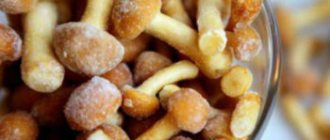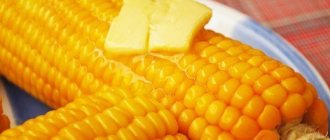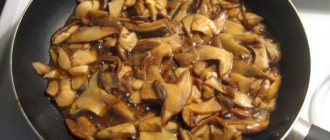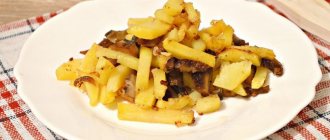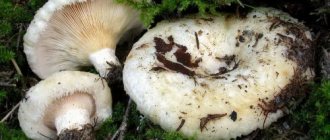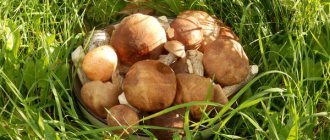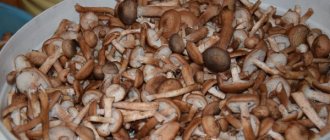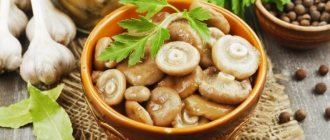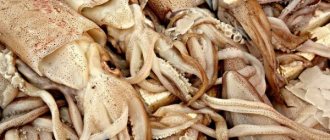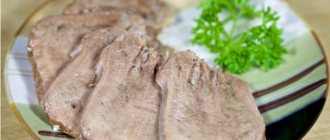Mushrooms
1
1500
Article rating
Kira Stoletova
Milk mushrooms are widespread edible mushrooms in Russia; they are popular in home canning in a number of regions. There are several varieties: white and black, creaking and pepper milk mushrooms, poplar milk mushrooms, yellow and many other types. However, most of them have a bitter taste, which, on the one hand, repels worms, but on the other hand, can be harmful to humans. Therefore, the main stage in preparation is soaking the milk mushrooms. We will tell you about important nuances, recipes and useful tips below.
Proper soaking of milk mushrooms
Preparation
White milk mushrooms are capricious mushrooms, so you will have to tinker a little with their preparation. Before cooking (for hot pickling), milk mushrooms are soaked for 1-3 hours in cold, lightly salted water. Mushrooms that will be salted cold must be soaked for three days, changing the water at least every 12 hours.
After soaking, rinse the milk mushrooms well under running water using a clean brush. Now you can start salting.
For hot pickling, milk mushrooms are soaked for 1-3 hours, for cold pickling – 3 days, for “dry” pickling they are not soaked at all.
Proven soaking recipe
Soaking rids mushrooms of toxins
If you soak mushrooms for 2-3 days in salted cold water (10 g of salt per liter of water) and change it 2 times a day, all toxic substances will go away.
Our ancestors even collected peeled mushrooms in a bag of nettles and sent them to a river or reservoir with running water for 3 days. You can try this simple method at your summer cottage.
Cleaning
Upon returning from the forest, the mushrooms should be placed in a metal or plastic container, filled with water and soaked for 20 minutes. This initial soaking is necessary so that the particles of forest dirt become slightly deoxidized and are easy to clean.
Each mushroom should be carefully examined for rottenness or the presence of worms. Remove dirt from a good mushroom with a knife along with the surface skin - film. After processing the outer side of the cap and stem, the spore-bearing plates from the inside of the cap should be removed. This procedure is carried out only with large (aged) mushrooms. Carefully trim the thin outer edge, which is folded inside the cap, and remove the white plates with a knife, moving from the stem to the edge. Some mushroom pickers use spoons for these purposes. You need to rinse with clean running water.
Ambassador of black milk mushrooms in jars for the winter
The peculiarity of pickling black milk mushrooms is that they retain their elastic texture after canning, and also have beneficial properties. This species does not look as beautiful and aesthetically pleasing as white milk mushrooms, but you can cook them very tasty.
Ingredients:
- black milk mushrooms – 2 kg;
- salt – 5 tbsp. l.;
- water – 1 l;
- vegetable oil – 50 ml;
- allspice and peppercorns – 12–15 pcs.;
- dry dill, cloves, bay leaf - to taste.
Cooking method:
- Soak the peeled fruits for 3 hours, constantly changing the water.
- Pour 4 liters of water into a deep container, add 5 tbsp. l. salt, stir. Boil the mushrooms in a saucepan for 20 minutes, constantly skimming off the foam.
- Prepare the brine: pour water into a saucepan, dissolve salt in it, add all the spices, bring to a boil.
- Place the boiled mushrooms in a separate container and fill them with boiling brine. Set the pressure and let the workpiece stand for 3 days.
- After this time, place the milk mushrooms with their caps down on the bottom of previously sterilized glass jars, fill with boiling brine so that 2-3 mm remains to the edges.
- Fill the remaining space with vegetable oil and seal with plastic lids.
- The preparation can be eaten within a month.
Is it necessary to soak milk mushrooms?
All mushrooms are divided into 4 groups according to their nutritional qualities:
- edible;
- conditionally edible;
- inedible;
- poisonous.
Edible specimens have high or good taste characteristics and are suitable for any culinary processing without preparation - they do not need to be pre-boiled or soaked.
The taste of conditionally edible mushrooms is mediocre. They are often bitter or pungent, too hard or elastic. They can be eaten, but after additional preparation - soaking for several hours or days and boiling for 20-25 minutes. After such manipulations, the sharpness, bitterness and hardness disappear. Inedible mushrooms are either tasteless or have an unpleasant taste and smell. They carry neither danger nor nutritional value for humans.
It is strictly forbidden to consume poisonous specimens, as they cause irritation to the mucous membrane of the digestive tract and lead to poisoning or even death. Since milk mushrooms are classified as conditionally edible mushrooms, and also because of their pungent taste, they must be soaked in water before cooking. After soaking in liquid, the pungency goes away.
Video: How to distinguish edible mushrooms from poisonous ones
How to remove bitterness from milk mushrooms without soaking
Soaking bitter milk mushrooms in water effectively helps remove the bad taste, but is a rather lengthy task. Many would like to somehow speed up the process and remove the bitterness from the mushroom pulp in a couple of hours.
Unfortunately, this cannot be done without any processing at all. The bitter taste depends on the presence of milky juice in the pulp, and the juice can only be removed with water.
But it is possible to remove the bitterness from white milk mushrooms without soaking for several days; an alternative is to quickly boil the fruiting bodies in salted water:
- During cooking, the milky juice leaves the mushroom pulp in the same way, only it can be removed faster than when soaking.
- To effectively remove the bitter taste, you need to boil the mushroom bodies with salt for 10 minutes, then drain the water and replace it with fresh water, and then put the mushrooms back on the stove for the same time.
- In total, the procedure is repeated 3 times, each time changing the water in the pan and not forgetting to salt it. When following the rules, the fruiting bodies lose their unpleasant taste and at the same time retain the white color of the pulp.
- When cooking, you must ensure that the water completely covers the fruiting bodies. If the caps protrude above the water, the bitterness may persist, since the processing will not affect the entire surface of the mushrooms.
The only drawback of this method is that boiled milk mushrooms are subsequently only suitable for frying, adding to soup or stewing. It is not customary to salt or pickle them, since boiled fruit bodies lose their pleasant elasticity and crispness.
Cooking eliminates unpleasant taste no less effectively
Important! To be safe, some mushroom pickers boil milk mushrooms three times for 30 minutes or more.
Practice shows that there is usually no need for boiling - it is possible to make milk mushrooms non-bitter much faster, and with prolonged heat treatment the fruiting bodies become too boiled.
How much to soak milk mushrooms and what delicious things to cook from them
Some types of mushrooms are so tasty and aromatic that it is simply impossible to resist them! The most favorite ones include porcini mushrooms, butter mushrooms, boletuses, boletus mushrooms, champignons, chanterelles and, of course, milk mushrooms! They are good in any form: boiled, fried, pickled. To surprise your guests with a fragrant mushroom dish, you need to know how long to soak the milk mushrooms. If you do everything right, you can't avoid praise.
Not all mushrooms can be peeled, washed and cooked. This type requires preliminary preparation, because without this it cannot be consumed. A dish made from unprepared mushrooms turns out to be bitter and tasteless, and all because of the sticky juice that they secrete.
How to cook milk mushrooms
Fried
Clean the mushrooms, remove the stems. Let it cook for half an hour. The foam needs to be removed. Drain the water, add fresh water and boil again for 20 minutes. Place the mushrooms in a colander to drain. After this, cut (into cubes or strips) and fry for about 10 minutes. If you add onions it will taste even better. The finished dish has a pungent taste and piquant aroma. How long should you soak milk mushrooms for this recipe? Thanks to long boiling, this will not be necessary.
Pickled
Place coarsely chopped dill on the bottom of a glass jar, and then lay out the milk mushrooms; it is better to choose young ones for this. You can also add garlic or horseradish root. Add salt to the water (the amount is at your discretion) and pour this brine into a jar. Wait 5 days and the dish is ready!
With sour cream
Cut the pre-prepared mushrooms into strips and fry in butter until they are browned. Add sour cream, pepper, salt, cover with a lid. You can also put spices there. Paprika and nutmeg go well with mushrooms. Simmer over low heat for no more than 10 minutes. When serving, sprinkle finely chopped dill on top.
If you know how much to soak milk mushrooms and do it correctly, you can create various culinary masterpieces with their help. Their excellent taste is worth the time and effort!
The long-awaited autumn has come again, and in forests, plantings or shelterbelts you can more and more often find people wandering with a basket in their hands. These are mushroom pickers. The canning of tomatoes and cucumbers is already behind us, and now people are wandering around in search of mushrooms in order to prepare at least some tasty salads or snacks for the winter. There are different types of edible mushrooms, there are a lot of them, but milk mushrooms are very prized among mushroom pickers. They grow everywhere, and there are practically no people who are not familiar with these mushrooms. That's why there is huge interest in them. There are many varieties of milk mushrooms: black milk mushrooms, white milk mushrooms, squeaky milk mushrooms and others. All of them are considered conditionally edible mushrooms. When raw, they taste very bitter and disgusting, although after skillful preparation you can eat them with great appetite. Proper preparation of such mushrooms begins with cleaning and subsequent soaking. How to clean them? How long should they be soaked before salting for the bitterness to disappear? Do they need to be boiled? For processing milk mushrooms, unlike other mushrooms, there are rules.
Features of soaking
It should be explained why the stage of soaking milk mushrooms is key and poor quality execution can lead to health problems. All types of milk mushrooms contain toxic substances in their milky juice in small quantities, which give a specific “bitter” taste and can cause poisoning.
Therefore, we advise you not to neglect the following recommendations:
- To avoid chemical reactions, we do not recommend using aluminum pans or tanks for soaking; it is better to give preference to enamel or wooden dishes.
- The water must completely wet the entire volume of mushrooms, otherwise, when exposed to air, raw mushrooms may oxidize and change color. If this happens, the mushrooms need to be washed and filled with new water, placing pressure on top, which will force them to completely disappear under water.
- If you decide to use warm water (which soaks milk mushrooms faster), add more salt and change the water often.
- Under no circumstances should you skip the time to change the water - otherwise the milk mushrooms may sour and become unsuitable for eating.
Fkusnofacts
— There is a lot of different debris on the surface of milk mushrooms, which is not so easy to clean off.
You can make this process easier with a regular toothbrush. Villi are capable of removing the smallest particles of leaves and dirt. You can also use a stiff sponge to wash dishes. When cleaning, mushrooms should only be washed under running water. The 2 most common types of milk mushrooms are black and white. Both are great for homemade preparations. Moreover, it is allowed to make pickles from both types of mushrooms at once.
— Before canning
Milk mushrooms must be soaked in order to remove the bitterness from them as much as possible. Black milk mushrooms are soaked for a period of 12 to 24 hours, and white milk mushrooms are left in water for up to 2 days. If both white and black milk mushrooms are used at once, you should soak them for 2 days. During this time, it is advisable to change the water several times. You can make sure there is no bitterness by tasting the mushrooms. To do this, just run the very tip of your tongue along the surface of the milk mushroom.
For making soup and fried milk mushrooms
It is not necessary to soak the mushrooms, because... bitterness acquires a bright taste only when prepared using a cold method.
When salting and marinating, milk mushrooms should be placed with their caps down. This way the mushroom will better retain its shape when compacted, will not break, and will also retain its taste.
The calorie content of milk mushrooms is 18 kcal/100 grams.
Sometimes during cooking, black milk mushrooms take on a purple or greenish tint. Don't be alarmed, this is a normal reaction for this type of mushroom.
You can go on a quiet hunt for milk mushrooms from August to September. They grow mainly in sunlit places in birch and mixed deciduous forests - in such places you can often find white milk mushrooms. They can often be found in thickets of young birch trees. Black milk mushrooms prefer to grow in sunny areas next to mosses.
Milk mushrooms are valued for their excellent taste, special aroma and beneficial properties. This mushroom is rich in ascorbic acid, vitamins B1 and B2, which have a beneficial effect in the treatment of various serious diseases.
Before frying, pre-soaked milk mushrooms must be boiled. 10 minutes is enough, then fry the mushrooms for 5-7 minutes over medium heat - When picking mushrooms, milk mushrooms can be confused with milk mushrooms. However, consuming the double can lead to stomach problems, nausea and vomiting. Despite the external similarity of mushrooms, the milkweed has a specific spicy smell. Particular attention should be paid to the cap of the mushroom - in a real young mushroom it is funnel-shaped, and its edges are turned inward.
If soaked for a long time, the mushrooms may darken: this is mainly due to improper soaking. It is necessary to wash the mushrooms and soak them in fresh water. To prevent the milk mushrooms from darkening, it is necessary to store the milk mushrooms under a weight during soaking - so that all the mushrooms are immersed in water.
Recipes
Milk mushrooms are traditionally salted in two ways: hot and cold. But a third one is also common - “dry”. Each of them has its own advantages and disadvantages: for example, if you salt white milk mushrooms using the hot method, it will not take much time, but the mushrooms will remain hard even after heat treatment, and the cold method will provide you with tasty and elastic mushrooms, but soaking them will take several days. Which method is better - choose for yourself. Photo and video recipes will help you with this.
Hot way
Hot pickling of white milk mushrooms in jars is the simplest recipe that does not require much time, special effort or expensive ingredients. With this salting, mushrooms quickly get rid of unpleasant bitterness and retain their elastic texture.
Number of servings/volume: 7-8 l
Ingredients:
- white milk mushrooms – 5 kg;
- rock salt (1.5-2 tbsp per 1 liter of water);
- black pepper in peas – 1-2 tbsp. l.;
- allspice in peas – 10 pcs.;
- bay leaf – 2 pcs.;
- dry cloves – 4 pcs.;
- dill - to taste;
- garlic – 4 cloves;
- black currant leaf – 4 pcs.
The cooking time for mushrooms depends not only on the variety, but also on the size and even the conditions in which the mushrooms grew. For milk mushrooms, this takes an average of 20 minutes, but it is better to determine readiness not by time, but by the moment when the mushrooms begin to settle to the bottom of the pan (if they “sink,” then they are ready).
Preparation:
- Place the pre-soaked milk mushrooms in a large pan of water, where they should float freely (there should be at least twice as much water in the pan as there are mushrooms). It is advisable to boil a large number of milk mushrooms in portions, in several batches (the water should be poured out after each serving). Pour 1.5-2 tbsp into the pan. l. salt per 1 liter of water and leave to simmer over medium heat for 15-30 minutes so that the salt dissolves and the mushrooms are well salted. Stir gently occasionally.
- Make the brine. Take another pan. For 1 liter of water add 2 tbsp. l. salt, add black and allspice, bay leaves, cloves and dill. Place the brine on low heat.
- 15-30 minutes passed, all the milk mushrooms “sank”. Drain the water from the boiled mushrooms through a colander, then transfer them to a pan with brine and boil for 30 minutes.
- Peel the garlic. Large cloves can be cut in half.
- At the end of half an hour, remove the pan with the brine and milk mushrooms from the stove, add the garlic, stir.
- Place washed currant leaves on top of the mushrooms, cover the pan with a small lid and press it down with not too heavy pressure so that the mushrooms are completely immersed in the brine. Place the makeshift tub in a cool, dark place. You can eat ready-made milk mushrooms within a week.
Bon appetit!
Cold way
Cold pickling does not require heat treatment of mushrooms, but you will have to wait a long time for the finished delicacy. But the result in the form of cool and elastic milk mushrooms, pleasantly crunching on the teeth, compensates for all expectations!
Number of servings/volume: 7-8 l
Ingredients:
- white milk mushrooms – 5 kg;
- rock salt – 250 g;
- garlic – 1 head;
- bay leaf – 5 pcs.;
- black currant leaf – 5 pcs.;
- black pepper in peas - 1 tbsp. l.;
- horseradish, root – 1-2 pcs.;
- sugar – 1 tsp.
Preparation:
- Clean and wash the milk mushrooms, then soak for 3 days, being sure to change the water twice a day.
- At the end of the period, thoroughly rinse and salt the mushrooms again, pouring salt into the bottom of a clean enamel container. Place a layer of soaked mushrooms on top of the salt, cover them with a layer of salt and repeat until you run out of mushrooms. Halfway through the process, add a little sugar between the layers of mushrooms to stimulate the formation of lactic acid bacteria.
- Cover the mushrooms with an inverted plate and lightly press it down with a weight (for example, a three-liter jar of water), leave the container in this form for a day. After this, the milk mushrooms will release a large amount of juice and will be ready for the next stage of pickling.
- Cut the garlic and horseradish into thin slices. Place the prepared mushrooms in jars in moderately dense layers, layering them with pepper, horseradish, garlic, as well as bay and currant leaves.
- Close the jars with lids - not airtight, so that the milk mushrooms are well salted and fermented. Place them in the refrigerator or cellar for a month. The temperature of the room in which pickled mushrooms are stored should not exceed +5 ℃ - otherwise the milk mushrooms will sour. If the temperature is below zero, the mushrooms will freeze and lose a significant part of their excellent taste. The top milk mushrooms should not come into contact with air - watch this and constantly add brine to them, otherwise they will quickly become covered with mold. If all the salting rules are followed, in a month you will have very tasty white milk mushrooms, which you can use both as an addition to dishes and as an independent snack.
Bon appetit!
Don’t be lazy and take additional “insurance” against botulism infection - pasteurization of filled jars (carried out immediately before sealing them).
Dry method
The third method of salting milk mushrooms is “dry”. Not only are the mushrooms not soaked, but they are not even washed. Simply clean it of forest debris and soil and wipe it with a clean cloth.
With the “dry” salting method, milk mushrooms are not soaked
Then they proceed as with cold salting: they are placed in a container in layers, sprinkled with coarse salt (not iodized), they are placed under pressure and kept in a cool place for 25-30 days. At the same time, the milk mushrooms release juice and settle. If this happens in a place where you can still pick up mushrooms, they can be added to a container (enamel pan) in portions, again sprinkled with salt. And then transfer the mushrooms into jars and put them in the refrigerator.
Milk mushrooms prepared using the “dry” method turn out to be very tasty, although spicy, “not for everyone.” Before eating, such mushrooms are washed, cut into slices, mixed with chopped onions and garlic and seasoned with vegetable oil.
Store salted or pickled milk mushrooms for no longer than a year.
A cold method of pickling mushrooms that does not require boiling them
It is not necessary to boil milk mushrooms before salting. There are methods for processing components in which heat treatment is not carried out at all. There are many recipes, here is the simplest and most popular of them:
- For 10 kg of mushrooms we take 0.5 kg of coarse table salt.
- We take a wooden barrel or a tall enamel container and begin to place the mushrooms in it, caps down. Sprinkle each layer with salt. Of course, it is difficult to calculate how much salt to use for each layer the first time. The optimal option is one in which 1 kg of mushrooms are used per layer. In this case, 10 layers are obtained, each of which is sprinkled with 50 g of salt.
- We place a wooden disk wrapped in gauze on the workpiece, or simply cover it with a cloth, and place a smaller dish or lid on top.
- We definitely use the cargo. This could be a stone or some kind of container with water.
- The entire structure must be placed in a cool place with a temperature no higher than 15-16ºС. We decide how long to wait, depending on the desired result. But the first sample should be taken no earlier than 2 weeks later.
Before using cold salting methods, it is necessary to assess all the possible risks of this approach. You should not resort to it if the mushrooms were not collected, but purchased. When working with products from the market or from a store, it is better to use preservation options based on heat treatment of the components.
In what bowl to soak milk mushrooms?
When soaking, it is important to choose the right dishes. You need to be guided by the following facts:
- Enameled, glass and wooden containers are considered safe;
- enamel dishes must be free of chips and cracks;
- the container must be of sufficient volume so that the milk mushrooms in it are completely hidden by water and there is room for oppression;
- You cannot use aluminum cookware, this leads to a chemical reaction and spoilage of the product;
- If you plan to soak with salt, you should not use a plastic container - there is a risk of releasing toxic substances.
Advice! Oak barrels are great for soaking. In them, the raw materials are salted, that is, soaked in brine. At the same time, the preparations acquire a special aroma.
pickling milk mushrooms!
Ingredients for the recipe for pickling milk mushrooms:
- milk mushrooms – 5 kg;
- medium salt – 2 cups;
- dill tubes without umbrellas;
- horseradish root and leaves;
- garlic;
- cherry or currant leaves.
Recipe for pickling milk mushrooms:
1. Clean and wash the mushrooms.
2. Then transfer them to enamel, plastic or glass dishes. A bucket, basin or wide saucepan is suitable for this purpose.
3. Fill with cold running water and cover with a large flat plate. We place a small pressure on top (a jar filled with water).
4. Place the mushrooms in a cool place for 3 days. Change the water to fresh water 3 times a day.
5. After this, take out the milk mushrooms, sprinkle each mushroom with salt and put it in a container for pickling.
6. Next, place peeled garlic cloves and pieces of horseradish root between the layers.
7. Cover the mushrooms completely with gauze folded 2-3 times.
8. Place horseradish leaves on cheesecloth (so that the milk mushrooms do not darken), and put the remaining greens on top.
9. Place pressure on the circle so that the mushrooms are completely covered with it after the brine is released.
10. Place the container with mushrooms in a cool place for 1 month. Make sure that the top mushrooms do not remain dry, otherwise they will become moldy.
11. After the mushrooms have been salted, transfer them to sterilized jars without screwing on the lids, or leave them for cold storage in the same container.
After such salting, all milk mushrooms remain snow-white and clean, the top layer can be washed. In winter, delicious and simple salads, caviar, festive https://chudo-povar.com/zakuski-na-den-rozhdeniya-recepty-s-foto/ and even low-calorie cutlets are prepared from salted mushrooms.
Hot pickling of mushrooms
Hot salting is done as follows. Mushrooms are cleaned and sorted; The roots of boletus, boletus and aspen are cut off, which can be salted separately from the caps. Large caps, if they are salted together with small ones, can be cut into pieces. The prepared mushrooms are washed with cold water, and the mushrooms are soaked for
Pour 0.5 cups of water into the pan (per 1 kg of mushrooms), add salt and put on fire. Mushrooms are placed in boiling water. During cooking, the mushrooms must be carefully stirred with a paddle so that they do not burn. When the water boils, you need to carefully skim off the foam with a slotted spoon, then add pepper, bay leaf, and other seasonings and cook with gentle stirring, counting from the moment of boiling: porcini mushrooms, boletus and boletus, valui mushrooms and russula
How to soak milk mushrooms correctly?
White milk mushrooms are soaked in clean water for at least a couple of hours.
Many housewives do not really like these gifts of nature. You have to tinker with them too much. Let's find out how long to soak white milk mushrooms? First you need to clean them. Fresh mushrooms are soaked in clean water for at least a couple of hours. This is necessary so that dirt and leaves can be easily cleaned.
Mushrooms are light in weight. To prevent them from floating up, they are pressed down under pressure. It is very important that the mushrooms are completely submerged in water. To soak half a bucket of milk mushrooms, you will need a bucket of clean water. After a couple of hours, the water is drained and cleaned. Regular changes of water are necessary, otherwise the mushrooms will simply spoil.
During the cleaning process, the mushrooms are sorted. Those that are wormy and wrinkled are thrown away. To clean milk mushrooms, it is most convenient to use a knife with a small blade. Young mushrooms are easy to clean with a toothbrush. After the milk mushrooms are cleaned, they are soaked again.
Return to contents
Clean milk mushrooms correctly!
Each stage of mushroom preparation is important. And cleaning is one of the main points. Many recipes don't even mention that mushrooms need to be cleaned. But starting to cook without pre-processing is at least reckless. Mushrooms are heavy food, and the largest amount of harmful substances always accumulates in the upper covers. Mushrooms themselves absorb everything harmful from the environment, which is why properly processing them before pickling or frying is a matter of life and health for you and your family.
So, when the mushrooms have already been soaked for several days, all the spoiled areas have been cut off, we begin cleaning. This is convenient to do with a stiff brush. To avoid searching for anything in stores, use any unnecessary toothbrush. Also a good, but less convenient option is a dish sponge with a hard surface. The mushrooms are cleaned to an even white color. Sometimes you can find information that black and white milk mushrooms are cleaned the same way. In principle, this is true, but you also need to additionally remove mucus from the black ones, which does not improve the taste of the finished dish.
Dry milk mushrooms are not soaked for days because they do not taste bitter. They can be cleaned almost immediately. The only secret is that mushrooms soaked in boiling water are much easier to clean. After soaking, the hat becomes soft and it is much more convenient to clean it of dirt by simply placing it under running water. Dry milk mushrooms do not need to be kept in brine for a long time, since they do not secrete bitter milky juice, like white and black ones.
Preparing mushrooms
Mushrooms must be peeled before cooking.
Preparing milk mushrooms for boiling is a long and rather labor-intensive process. It includes:
- manually cleaning each specimen from visible lumps of earth, blades of grass, and other foreign particles (old and damaged mushrooms touched by worms are not suitable for pickling);
- soaking in cold water in a spacious container (basin, bathtub) for several hours (preferably for a day), and the water must be changed periodically;
- thoroughly washing each mushroom in clean water (some even recommend using a toothbrush for this purpose);
- removal of long legs;
- Large caps can (but not necessarily) be cut into slices.
If soaked for a long time, the milk mushrooms may darken. This usually happens because they are not completely submerged in water. Therefore, the mushrooms must be washed and soaked again in new water. But put a weight on top so that they are all under a layer of water.
How to salt milk mushrooms under pressure
Salting milk mushrooms under pressure is painstaking work; the process may seem too complicated for the first time. There are hot and cold methods of pickling, the first is faster, the second is tastier. The preparation of mushrooms in both cases is the same; this stage must be treated especially responsibly, otherwise the preparations will deteriorate.
Preparing milk mushrooms for salting
Before the milk mushrooms are ready for pickling, they require thorough cleaning. Earth, grass and pine needles easily stick to their caps, so they need to be cleaned well. The film is removed from the black mushrooms - they still need to be washed first. Especially a lot of dirt is hidden under the cap; it can be removed with a small brush or metal sponge.
The milk mushrooms must be cleaned of dirt with a small brush or metal sponge.
Advice! Using running water for rinsing is not the best option. It is recommended to purchase purified water and wash the mushrooms in it. The villages use spring water.
The stems are not used in pickling; they need to be cut off, leaving 1-2 cm at the cap itself. After the mushrooms are thoroughly washed from plant debris, cut large specimens in half, leaving small ones intact. Damaged and very old milk mushrooms should absolutely not be used.
The next stage is soaking, the mushrooms are cleaned of toxins and bitter juice. Place the raw materials in a large container, pour water so that it covers the top layer. Then place the oppression on top. Mushrooms are soaked for 2-3 days, the water needs to be changed regularly:
- the first 12 hours – every 2 hours;
- 12-24 hours – every 5 hours;
- further - as the water becomes cloudy.
After the water stops being bitter, rinse the mushrooms, and you can marinate the milk mushrooms under pressure in a convenient way.
How to salt milk mushrooms under pressure in a cold way
This method has several variations - with spices and onions. It is not very spicy, but aromatic.
To prepare you will need:
- soaked milk mushrooms - 1 bucket;
- salt – 2 faceted glasses;
- black peppercorns - 1 package;
- currant leaves - 20 pieces;
- dill umbrellas – 10 pieces;
- garlic cloves – 10 pieces;
- bay leaf - packaging.
Important! You cannot use iodized salt, only table salt. Cold-salted milk mushrooms are not very spicy and aromatic
Cold-salted milk mushrooms are not very spicy and aromatic
The procedure for salting milk mushrooms using the raw method under pressure:
- Place mushrooms in an enamel pan or bucket, caps down.
- Distribute 2-3 tbsp onto each layer. l. salt - depends on the size of the dish.
- Place bay leaves, currant leaves, peppercorns and chopped garlic on a layer of raw materials.
- Distribute all the milk mushrooms in layers.
- Place dill umbrellas on the top layer, cover the pan with a lid (it should lie directly on the mushrooms) and press down with pressure. Place in a cool, dark place for 4-6 days.
- Milk mushrooms form juice that completely covers their mass. If this does not happen, you need to find a bigger press.
- After the expiration date, place the raw materials into sterilized jars and pack tightly.
- Pour in the brine and add an umbrella of dill. Squeeze out any air bubbles from the jar and seal with a sterile plastic lid.
Put the milk mushrooms in a cool place for 30-40 days, but some people prefer to eat mushrooms a little earlier than this. However, the fruiting bodies may not be ready yet, especially if salting is carried out for the first time.
How to pickle milk mushrooms under pressure in a hot way
Using hot brine, you can get the finished product faster due to heat treatment.
- milk mushrooms – 3 kg;
- bay leaf – 3 pieces;
- cloves - 3 pieces;
- onions - 3 onions;
- garlic cloves – 3 pieces;
- dill umbrellas – 3 pieces;
- mustard seeds – 0.5 tbsp. l.;
- vegetable oil;
- oak and cherry leaves - 5 pieces each;
- a piece of horseradish root;
- salt – 180 g.
Milk mushrooms give juice - they need to be placed in jars, leaving space up to the lid
For the hot method, milk mushrooms need to be soaked for 24 hours. The further procedure looks like this:
- Wash the soaked mushrooms and cook 3 times for 10 minutes, each time in new water.
- Wash the boiled milk mushrooms and lay them out to dry.
- Line the bottom of sterilized jars with oak and cherry leaves.
- Sprinkle with a thin layer of salt and arrange the milk mushrooms.
- Place the mushrooms in layers, between them: salt, onion half rings, mustard, bay leaf and dill.
- Press the milk mushrooms to let the air out.
- Pour 3-4 tbsp into jars. l. vegetable oil.
- Cover the necks with permanent paper and place in the cold.
After a week, you need to check - if the mushrooms are not completely covered with brine, add boiled water.
Important! Mushrooms need to be placed in jars, leaving a small space so that there is room for the brine that is released
How many days should milk mushrooms be soaked before salting?
The duration of soaking of milkweeds depends on their type and the method of salting. Preparation may take hours or days.
How long to soak milk mushrooms before cold salting
This method of pickling mushrooms takes longer, but better preserves the taste and aroma. They need to be soaked for at least 3 days, but no longer than a week. The specific timing also depends on the size of the mushrooms - small and cut into pieces specimens should be kept in water less.
Important! When salting in a cold way, the preparations can be consumed after at least 30-40 days.
How long to soak milk mushrooms before hot salting
This method is usually used for black milkies. If you need to soak milk mushrooms for pickling using a hot method, the duration of processing depends on the recipe. The recipe may require repeated cooking of mushrooms; each time the liquid must be drained and replaced with fresh water. In this case, a few hours of pre-soaking is sufficient. The water must be changed every half hour.
If the heat treatment is short-lived, then the milkweeds need to be soaked for 2-3 days. In hot weather, change the water more often so that the raw materials do not spoil.
One option for pickling mushrooms is soaking only after cooking. You need to cook for 15 minutes, then keep it in brine under pressure for a week. After this treatment, the milk mushrooms are placed in sterilized jars and stored in a cool place for 1-1.5 months.
You can cook milkweed in an enamel container or stainless steel container
You can cook milkweed in an enamel container or stainless steel container
How to prepare milk mushrooms for soaking
Preparation must begin with cleaning the raw materials. Some people do this after soaking, but then the fruit will be covered in dirt. They tend to absorb harmful substances from the environment, so proper attention must be paid to cleaning. The algorithm is as follows:
- Sort out the milkies. If the specimens are completely damaged or too loose, throw them away immediately. Cut out wormy areas.
- Soak the mushrooms for 1-2 hours in cold water if they are very dirty. After this, rinse each milkweed. Before further processing, do not drain, but remove one specimen from the cleaning liquid at a time.
- Remove dirt. At the same time, you need to remove the film from the surface. If the fruits are large, then remove the plates with spores from the inside of the caps. It is convenient to do this with a spoon.
- Cut the milk mushrooms. This step is optional. You need to act depending on the chosen salting method and personal preferences. The caps are considered the best for pickling, and the legs can be left for preparing caviar or frying. It is better to cut large specimens into 2-4 parts.
It is convenient to use an old toothbrush for cleaning.
Important! It is better to start processing on the day of collection or purchase, no more than a day should pass. If the harvest was harvested in the rain, then it can be left for no more than 5-6 hours before cleaning and soaking.
Video
We offer you to watch a video that tells about another recipe for salting white milk mushrooms:
About the author:
Anna Borovkova Freelancer with diverse interests and hobbies. Likes to be close to nature, eat delicious food and philosophize about the eternal. She has been writing articles on a variety of topics for so long that she is already erudite in the most unexpected areas. Loves forests, flowering gardens, space and fried potatoes with smoked ribs. He doesn’t like to stand at the stove, but among his friends there are several professional chefs who will always feed you delicious food and share cool recipes. Pathologically optimistic.
Found a mistake? Select the text with the mouse and click:
Ctrl + Enter
Did you know that: In small Denmark, any piece of land is a very expensive pleasure. Therefore, local gardeners have adapted to growing fresh vegetables in buckets, large bags, and foam boxes filled with a special earthen mixture. Such agrotechnical methods make it possible to obtain a harvest even at home.
Natural toxins are found in many plants; Those grown in gardens and vegetable gardens are no exception. Thus, the seeds of apples, apricots, and peaches contain hydrocyanic acid, and the tops and peels of unripe nightshades (potatoes, eggplants, tomatoes) contain solanine. But do not be afraid: their number is too small.
Convenient Android applications have been developed to help gardeners and gardeners. First of all, these are sowing (lunar, flower, etc.) calendars, thematic magazines, and collections of useful tips. With their help, you can choose a day favorable for planting each type of plant, determine the timing of their ripening and harvest on time.
Both humus and compost are rightfully the basis of organic farming. Their presence in the soil significantly increases the yield and improves the taste of vegetables and fruits. They are very similar in properties and appearance, but they should not be confused. Humus is rotted manure or bird droppings. Compost is rotted organic remains of various origins (spoiled food from the kitchen, tops, weeds, thin twigs). Humus is considered a higher quality fertilizer; compost is more accessible.
“Frost-resistant” varieties of garden strawberries (more often simply “strawberries”) need shelter just as much as ordinary varieties (especially in those regions where there are snowless winters or frosts alternating with thaws). All strawberries have superficial roots. This means that without shelter they freeze to death. Sellers’ assurances that strawberries are “frost-resistant,” “winter-hardy,” “tolerates frosts down to −35 ℃,” etc. are deception. Gardeners must remember that no one has yet managed to change the root system of strawberries.
One of the most convenient methods for preparing a harvest of vegetables, fruits and berries is freezing. Some believe that freezing causes the nutritional and health benefits of plant foods to be lost. As a result of the research, scientists have found that there is practically no decrease in nutritional value when frozen.
In Australia, scientists have begun experiments in cloning several varieties of grapes grown in cold regions. Climate warming, which is predicted for the next 50 years, will lead to their disappearance. Australian varieties have excellent characteristics for winemaking and are not susceptible to diseases common in Europe and America.
The homeland of pepper is America, but the main breeding work on developing sweet varieties was carried out, in particular, by Ferenc Horvath (Hungary) in the 20s. XX century in Europe, mainly in the Balkans. Pepper came to Russia from Bulgaria, which is why it received its usual name - “Bulgarian”.
A new product from American developers is the Tertill robot, which weeds weeds in the garden. The device was invented under the leadership of John Downes (creator of the robot vacuum cleaner) and works autonomously in all weather conditions, moving over uneven surfaces on wheels. At the same time, it cuts off all plants below 3 cm with the built-in trimmer.
Cleaning milk mushrooms
Place them in a metal or plastic container, then fill them with water. Cleaning begins about twenty minutes after pouring: during this time, the dirt particles will loosen a little, the stuck leaves and insects will fall off.
Clean each mushroom separately. Having taken it out of the container with water, carefully inspect it. If the mushroom is old or wormy, then it is simply thrown away (experienced mushroom pickers do this in the forest: they rake up the foliage, place the unusable mushroom on the ground and rake it back with leaves, in this way preserving the spores for the next generation of mushrooms). If the mushroom is good, then debris is removed from its cap and the dirt is scraped off with a knife, usually along with the film. Then the stem of the mushroom is cleaned. Often, skilled people use other tools instead of a knife, for example, a hard toothbrush. The quality of cleaning with a brush is, of course, much better than with a knife, but it takes more time.
The next cleaning process is removing the plates. The plates of small mushrooms cannot be removed. Only large ones are removed. To do this, cut off a thin edge along the entire circumference of the cap, which is slightly turned inward in milk mushrooms. If you do not cut it, then when scraping the lamellar mass it will still break off, only there will be more mess. The plates are removed with a knife in the direction from the leg to the edge. The milk mushroom, cleared of debris and plates, should be rinsed with clean water and placed in a previously prepared container in which you are going to soak. But it is better if the mushrooms are cut into slices: they are less bulky and the bitterness is better removed from them.
Why do milk mushrooms turn black when soaked?
Mushrooms turn black when cut. This is due to the content of milky juice, which upon contact with air turns gray-yellow and then black. This happens if you soak milk mushrooms in insufficient water. It must cover the raw material completely.
Another possible reason for the blackening of milkweeds is exposure to sunlight. Soaked raw materials should be kept covered or in a dark place.
Blackening is not a reason to throw away mushrooms. They need to be washed, immersed in cold water and kept under load for several hours. It is recommended to use raw materials for hot salting.
Advice! To prevent the lacticaria from starting to darken even at the cleaning stage, each processed specimen must be immediately placed in water.
How to properly salt black milk mushrooms?
Methods for salting black milk mushrooms at home are numerous and have a lot of variations. Each version is good in its own way, allowing you to get a decent snack in all respects. Having mastered the stage of cleaning and soaking, all that remains is to fulfill the requirements of the chosen recipe.
- The milk mushrooms are placed in a suitable container. Oak barrels, enamel, ceramic or glass containers are suitable.
- The mushroom mass is supplemented with herbs, herbs, garlic and spices.
- When dry salting, the mushroom mass is sprinkled with salt, pressed with a weight and left for a couple of days at room conditions.
- During hot salting, after cooling, the workpiece is put into the cold.
- You can try salted black milk mushrooms after 40 days.
How to salt black milk mushrooms - a simple recipe?
A quick way to pickle black milk mushrooms will be especially easy. The appetizer can be prepared without additional labor and will delight you with its excellent taste characteristics and rich mushroom aroma. To implement the recipe, non-iodized salt is used, and the weight of the load is selected so that within 24 hours the mushrooms are completely covered with juice.
Ingredients:
- black milk mushrooms;
- salt – 50 g per 1 kg of mushrooms.
Preparation
- The milk mushrooms are placed in a container with their caps down, sprinkling the layers with salt.
- Press the mass with a weight and leave for 3 days at room conditions.
- The mushrooms are sent into the cold for 1.5 months in the original container, or they are first placed in jars with the marinade.
How to salt black milk mushrooms in a cold way?
Salting black milk mushrooms in a cold way according to the following recipe involves obtaining a more piquant and spicy taste of the snack. At the bottom of the vessel in which the mushroom mass will be placed, put all kinds of greens, spicy additives, pepper pods, garlic, and in some cases, onions cut into large rings.
Ingredients:
- black milk mushrooms;
- salt – 45 g per 1 kg of mushrooms;
- currant leaves, dill umbrellas, garlic, bay, allspice, cloves.
Preparation
- Mushrooms are placed together with spices, herbs and additives in a container, sprinkling the layers with salt.
- Press the mushroom mass with a weight and leave for 3 days.
- Take the workpiece out into the cold
- Spicy pickling of black milk mushrooms will last at least 40 days.
Hot pickled black milk mushrooms
Salting black milk mushrooms in a hot way for the winter is as safe as possible. Heat treatment completely removes any remaining bitterness, unpleasant odor, and destroys harmful toxins. However, you should not neglect the preliminary soaking of the mushroom mass and limit yourself to just cooking.
Ingredients:
- black milk mushrooms;
- salt – 40 g;
- water – 1 l;
- currant leaves, dill, garlic, bay, horseradish root, allspice, cloves.
Preparation
- Dissolve salt in a liter of water, boil it, add mushrooms.
- Boil milk mushrooms for 15 minutes, drain and wash.
- Prepare a new portion of brine from water and salt, add spices, and boil for 5 minutes.
- Mushrooms with herbs, garlic and horseradish are placed in a pickling container, filled with brine, and pressed with a weight.
- After 5 days, put the mass into jars and put them in the cold for 40 days.
How to pickle black milk mushrooms so they are crispy?
From the following recipe you can learn how to salt black milk mushrooms so that they are as crispy and tasty as possible. The secret to obtaining a characteristic crunch lies in adding horseradish leaves and roots, previously scalded with boiling water, to the container with pickles on the bottom and on top of the mushroom mass.
Ingredients:
- black milk mushrooms;
- salt – 50 g;
- water – 1 l;
- currant, oak, horseradish leaves, dill, garlic, bay, allspice.
Preparation
- The milk mushrooms are placed in a container, at the bottom of which half of the herbs and spices are placed.
- Cover the mushroom mass with oak and horseradish leaves.
- Boil water with salt, cool, pour brine over the milk mushrooms.
- Press the contents of the container with a weight, and after 5 days put them in the cold.
- You can try salted crispy black milk mushrooms after 40 days.
What to do if a smell appears when soaking milk mushrooms
When soaked, milkweed can turn sour, resulting in a smell reminiscent of sauerkraut. The reason lies in the rare change of water or high room temperature. If the smell is strong and abundant foam appears, then it is better not to risk it and throw it away. Otherwise, you may get poisoned.
When an unpleasant odor has just begun to appear, and the liquid has been changed almost without delay, then it is possible to save the mushrooms. If you no longer need to soak them, you should first rinse them and then salt them using the chosen method. Make the saline solution strong. If further soaking is required, then rinse the raw materials, add fresh water and observe. If the smell reappears or gets stronger, throw out the milkweeds.
How to cook pickle with milk mushrooms
Products
Milk milk (fresh or canned) - 400 grams Onion - 2 heads Tomato - 2 pieces Pickled cucumber - 2 pieces Olives (pitted) - 15-20 pieces Parsley root - 15 grams Butter - 2 tablespoons Water or broth - 1, 5 liters Bay leaves - 2 pieces Salt, hot pepper and black peas - to taste Herbs and lemon - for decoration
How to cook pickle soup with milk mushrooms
1. Thoroughly clean 400 grams of milk mushrooms under running water to remove adhering grass, leaves and dirt, and cut into pieces. If canned mushrooms are used to prepare the pickle, then they also need to be rinsed from the brine. 2. Peel 2 onions, 15 grams of parsley root and finely chop. 3. Heat a frying pan, melt a tablespoon of butter; fry onions, mushrooms and parsley. In another skillet, melt 1 tablespoon of butter and simmer 2 pickled cucumbers, cut into cubes. 4. Pour 1.5 liters of water or broth into the pan, boil, add fried vegetables and mushrooms, and cook over moderate heat for 15 minutes. 5. Wash 2 tomatoes, cut into slices and add to the soup along with 2 tablespoons of chopped olives. 6. Season the pickle with a few black peppercorns, add 2 bay leaves, salt and hot pepper to taste, and stir. 7. Boil the soup until done. Before serving, it is recommended to add herbs and a slice of lemon to the plates.
How soon can you eat pickled and salted milk mushrooms?
Of course, in most cases we pickle and salt in the winter, but you still want to try the mushroom delicacy right away, especially with a large family circle, which most often gathers in the summer and early autumn. Lightly salted milk mushrooms can be tried a week after hot salting, and a month after cold salting; pickled milk mushrooms can be opened after 3-5 days.
How soon can you eat pickled and salted milk mushrooms?
Distribution and collection features
The distribution areas of milk mushrooms are deciduous or mixed forests: birch, birch-pine, with linden undergrowth. The comfortable soil temperature required for their growth and reproduction is from +8 to +11°C. Therefore, they are practically not found in the south of Russia and Europe, preferring the northern regions of the temperate climate zone.
Milk mushrooms grow in July - September. If the weather is warm and rainy, they can occur in early October. They don’t like heavy rains; mushrooms quickly deteriorate after it. They also do not like long dry weather, but appear after a long drizzling “mushroom” rain. Milk mushrooms grow in large groups. If one mushroom is found, a whole family of them is sure to nest somewhere nearby, camouflaged by a dense cover of fallen leaves or pine needles.
Adult milk mushrooms can reach enormous sizes. The cap, with a diameter of 5 to 20 cm, looks like a funnel on top and has a wet surface. The stem is cylindrical, smooth, its height is up to 8 cm, its diameter is up to 5 cm. The color of the cap depends on the type of mushroom. It can be yellow, white and even black. When broken, it releases a caustic white juice, which, when exposed to air, quickly acquires a sulfur-yellow color. At the bottom, the cap consists of white wide plates.
We recommend reading: How to Preserve Beets for the Winter in a Warm Cellar
Not all milk mushrooms are edible. Particularly dangerous is the camphor milk mushroom, or camphor milkweed, which can cause severe poisoning if it accidentally ends up in a basket. Its special characteristics: a brown cap with sparse yellow plates, the place where it breaks immediately darkens. But, fortunately, it is rare.
Preparing milk mushrooms
Pour all the mushrooms onto a newspaper and sort them thoroughly. Without regret, get rid of those touched by worms, as well as old and wrinkled ones. Leave the most beautiful and elastic ones. Leaves, hay residues, and dirt can be removed with a brush. Rinse thoroughly. Turn each mushroom upside down and cover with water. She should be cold.
You may ask how long to soak milk mushrooms. Two days are enough to get rid of the unpleasant taste. This is provided that you remember to change the water to clean water every day.
You can also get rid of the bitter taste by salting. Just sprinkle the mushrooms with coarse salt. Only to release the juice you need to press them down with pressure from above.
Preparing for cleaning
Milk mushrooms are collected from August until the end of September.
Before peeling mushrooms, you need to prepare the following:
- Capacity. It should be deep, large (if there are at least 1 bucket of milk mushrooms) and round (to fit under the lid). This could be a basin, bucket or tank. If one container is not enough, you need to take two.
- Water. It is better to fill it with cold water, then all the insects present in the mushrooms will die. It is better to use well, spring or tap water to the coldest possible temperature.
- Knife. Needed to cut off the stem and clean the inside of the mushroom cap, otherwise called the spore-bearing layer. It is better to take a pointed knife with a short blade.
- Brush. Typically, a toothbrush or household tool with medium-hard bristles, as well as a dishwashing sponge, are used. You cannot use pipe cleaners and brushes with hard bristles: they leave grooves on the cap of the milk mushroom.
Result:
As a result, it must be said that the most important thing when collecting mushrooms, including milk mushrooms, is to know what mushrooms to collect, what to do with them, how to process them. You can read as much as you like about all these wisdom in books and on the Internet, but this is just help. The main work is wandering through the forest, collecting, doubtfully examining every mushroom found. Over time, experience comes, and the worries associated with collecting, cleaning, and soaking turn into annoying, but very pleasant chores.
Crispy salted milk mushrooms can decorate both everyday and holiday tables. But, as with any mushrooms, increased attention is paid to processing the mushrooms. You need to know how to clean the preparations, how long to soak them, when to cook them, and what is the best way to salt them.
It is worth considering that neglecting basic recommendations can, at a minimum, lead to a deterioration in the taste of the snack - improperly processed mushrooms taste bitter. Moreover, ignorance of the rules for working with mushrooms can provoke severe food poisoning.
